Brown Bear photos
The brown bear photos on this site may be licensed as stock photos or purchased as fine art prints for your home or office decor. All brown bear photos were taken throughout Alaska’s Interior, Coastal, Arctic, and Kodiak Island regions. More images can be accessed by searching the links below, browsing a gallery, or using a keyword search (top right) for a more specific query.
- Brown bears of the coast
- Brown bears of Katmai National Park
- Grizzly bears of Denali National Park
- Grizzly bears of the Arctic
Brown Bears (Ursus arctos)
While brown and grizzly bears are considered the same species, their diet differentiates their name description. The term “brown bear” refers to the members of this species found in coastal areas where the protein-rich salmon is the primary food source. Brown bears found inland and in northern habitats are referred to as “grizzly bears,” whose diet is mainly vegetarian. Brown bears on Kodiak Island are classified as a distinct subspecies from those on the mainland because they are genetically and physically isolated. The shape of their skulls also differs slightly. In this discussion, the brown bear refers to all members of the species Ursus arctos.
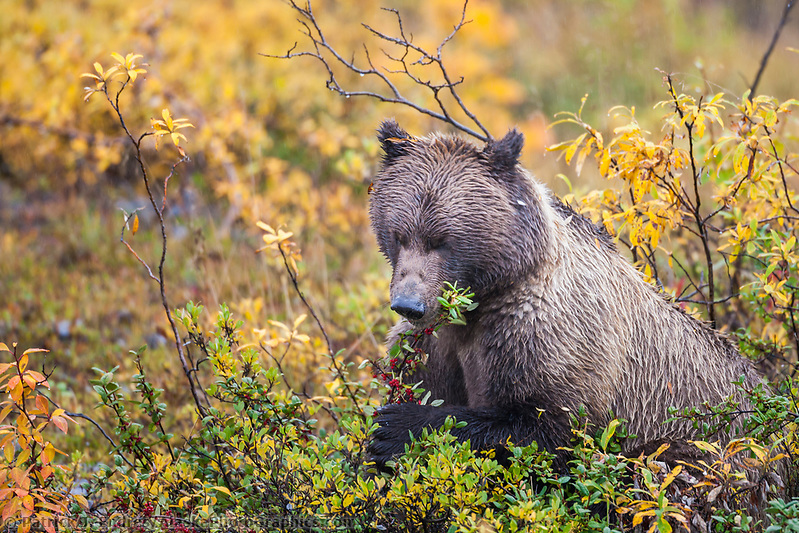
Grizzly bear feeds on ripe red soapberries on the autumn tundra in Denali National Park. Ⓒ Patrick J. Endres / AlaskaPhotoGraphics.com
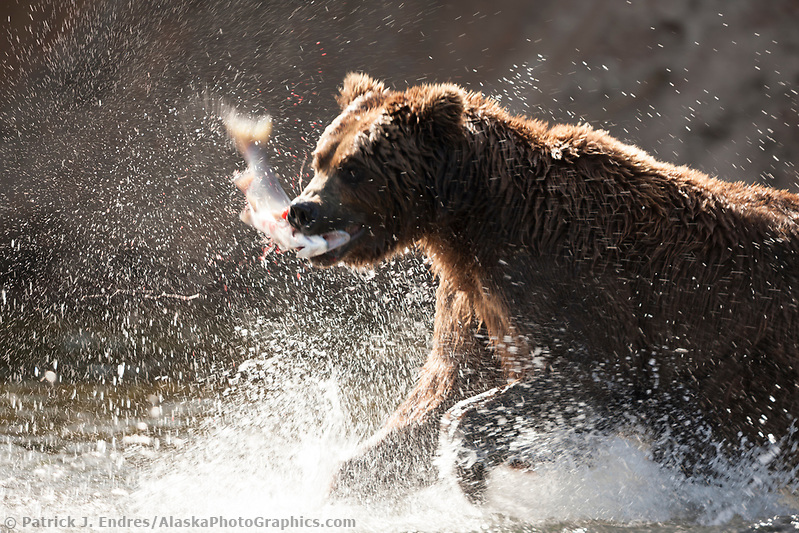
Brown bear lunge fishes for red salmon in the Brooks River, Katmai National Park, southwest Alaska. Ⓒ Patrick J. Endres / AlaskaPhotoGraphics.com
Body Description
The brown bear resembles its close relative, the black bear, Ursus americanus. Still, it is differentiated by larger body size, more prominent shoulder hump, less prominent ears, and longer, straighter claws. The large shoulder hump and the long claws are adaptations related to feeding behavior. The long claws are useful in digging for roots or excavating burrows of small mammals. The musculature and bone structure of the hump help dig and attain bursts of speed to capture prey.
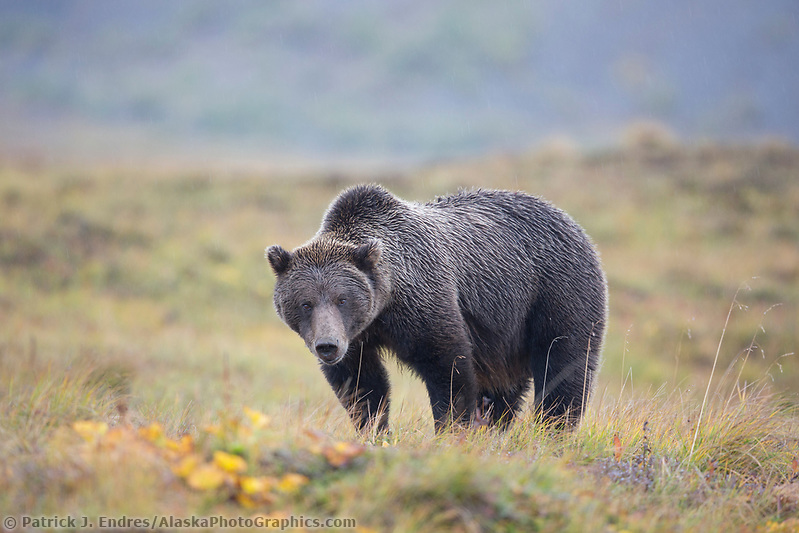
Grizzly bear on the tundra, Denali National Park, Alaska. (Patrick J Endres / AlaskaPhotoGraphics.com)
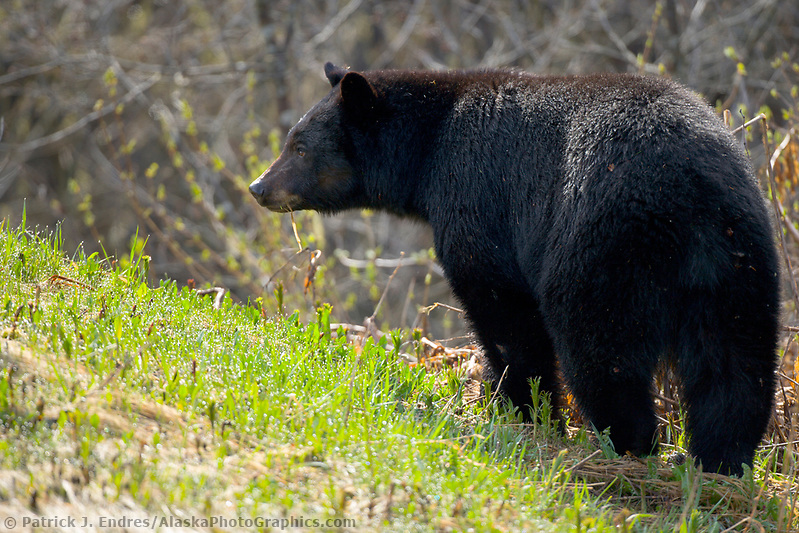
Note the difference in the less prominent hump on the back, larger ears, and flatter face of the black bear. Ⓒ Patrick J. Endres / AlaskaPhotoGraphics.com
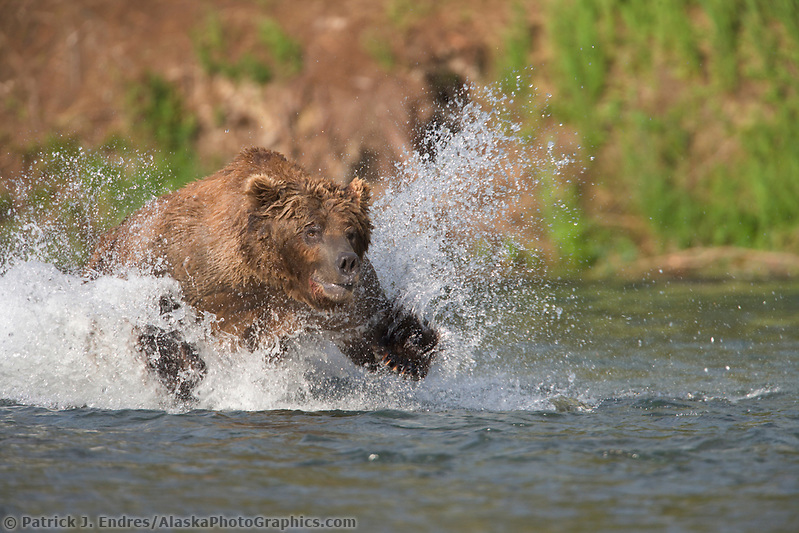
Brown bear lunge feeding for red salmon in the Brooks River, Katmai National Park, Alaska Ⓒ Patrick J. Endres / AlaskaPhotoGraphics.com
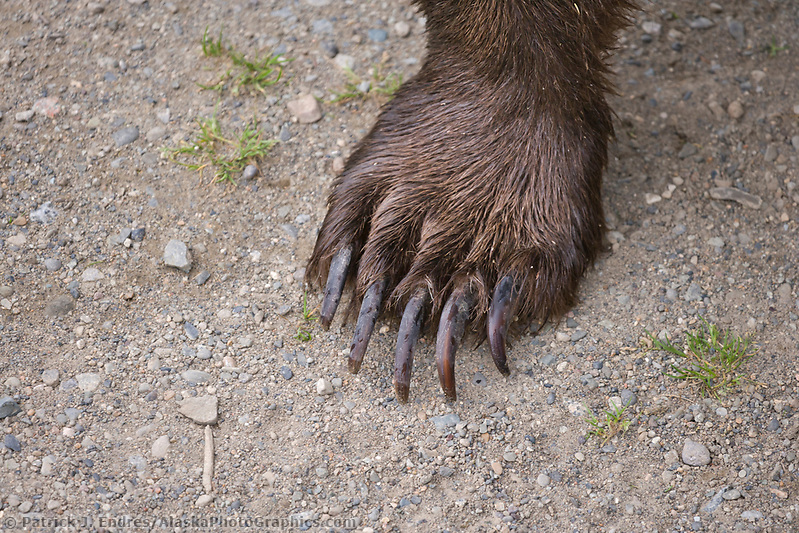
Brown bear claws, Katmai National Park, southwest Alaska. Ⓒ Patrick J. Endres / AlaskaPhotoGraphics.com
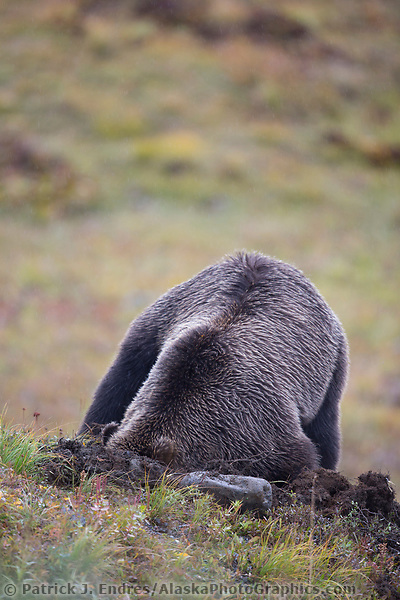
Grizzly bear digging for a ground squirrel in the tundra, Denali National Park, Alaska. (Patrick J Endres / AlaskaPhotoGraphics.com)
Color and Size
Color is unreliable for differentiating brown from black bears because both species have many color phases. Black bears appear in shades of brown, blue, and white, while brown bears range from dark brown to blonde. Mature male brown bears weigh between 500 and 900 pounds (180-410 kg), with enormous individuals weighing as much as 1,400 pounds (640 kg). Females weigh half to three-quarters as much. A huge brown bear may have a skull 18 inches long and stand 9 feet (2.7 m) tall.
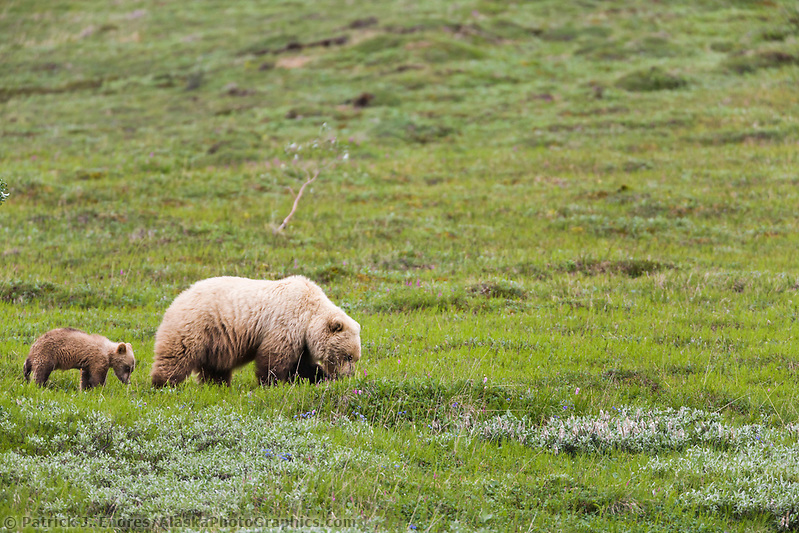
Blond-colored sow grizzly bear with spring cub on the tundra in Highway Pass, Denali National Park, Interior, Alaska. Ⓒ Patrick J. Endres / AlaskaPhotoGraphics.com
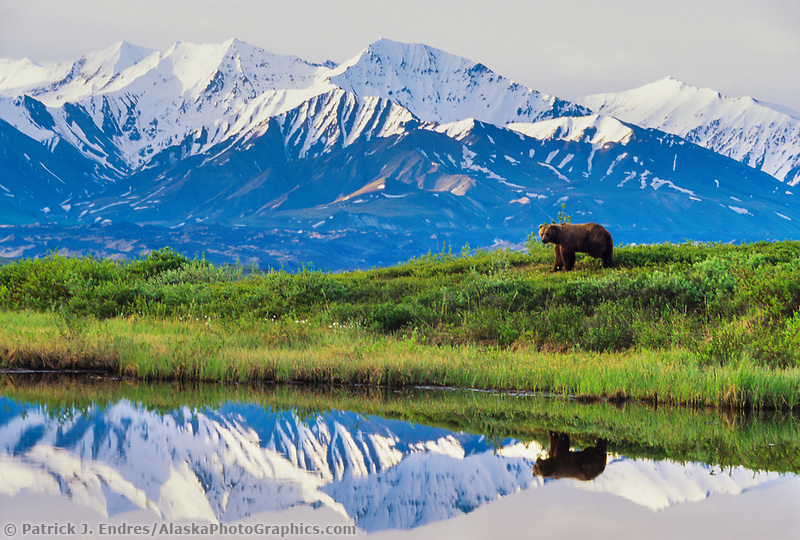
Dark colored boar grizzly bear, reflection in kettle pond, Alaska mountain range, Denali National Park, Alaska Ⓒ Patrick J. Endres / AlaskaPhotoGraphics.com
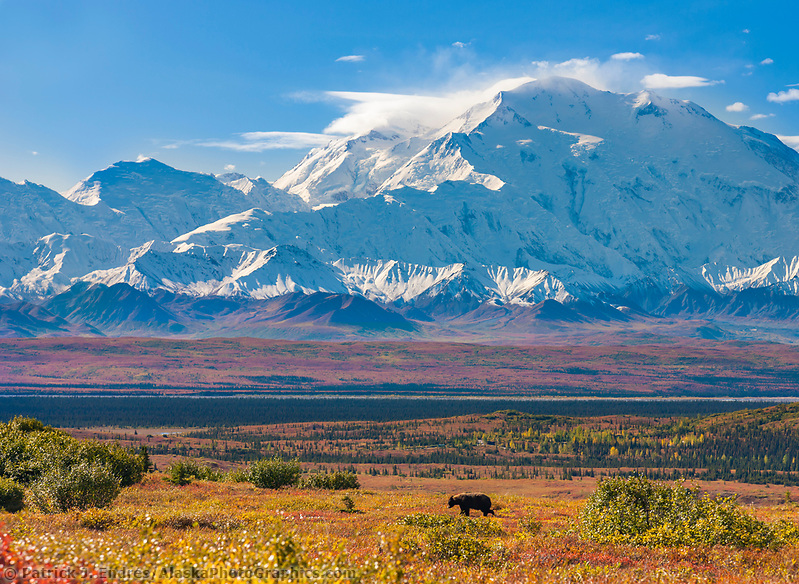
Cinnamon phase black bear feeds on blueberries on the autumn tundra near Wonder Lake, Denali of the Alaska Range mountains, Denali National Park, Interior, Alaska. Ⓒ Patrick J. Endres / AlaskaPhotoGraphics.com
Age
Brown bears liver to an average age of 22, although on occasion longer. They have an especially keen sense of smell and, under the right conditions, may be able to detect odors as far as a mile away. Their hearing and eyesight are probably similar to that of humans. When bears stand upright, it is not to get ready to charge but to test the wind and to see better.
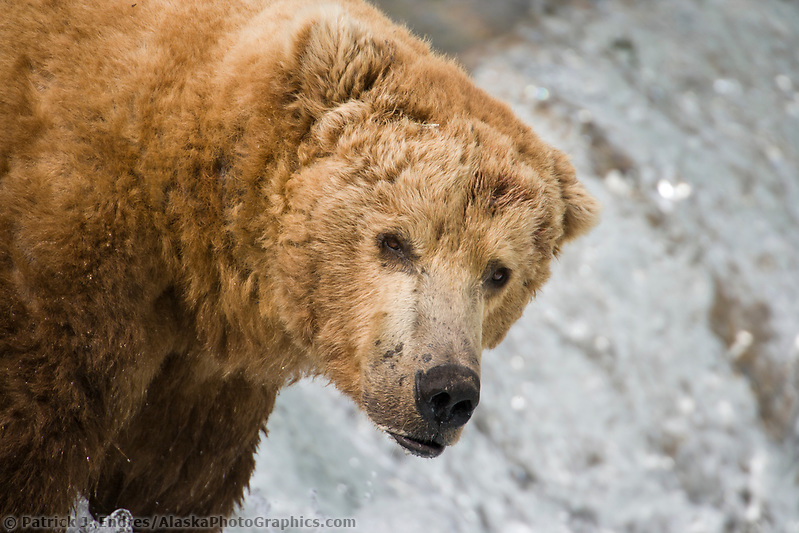
Old, scarred brown bear boar, Katmai National park, southwest Alaska. Ⓒ Patrick J. Endres / AlaskaPhotoGraphics.com
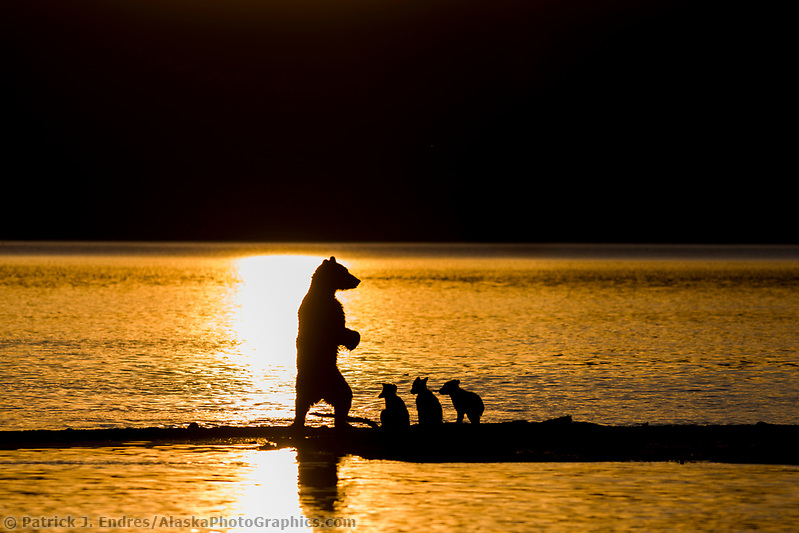
Brown bear sow and triplet cubs of the year fish for salmon on the spit of Brooks River and Naknek Lake, Katmai National Park, southwest Alaska. Ⓒ Patrick J. Endres / AlaskaPhotoGraphics.com
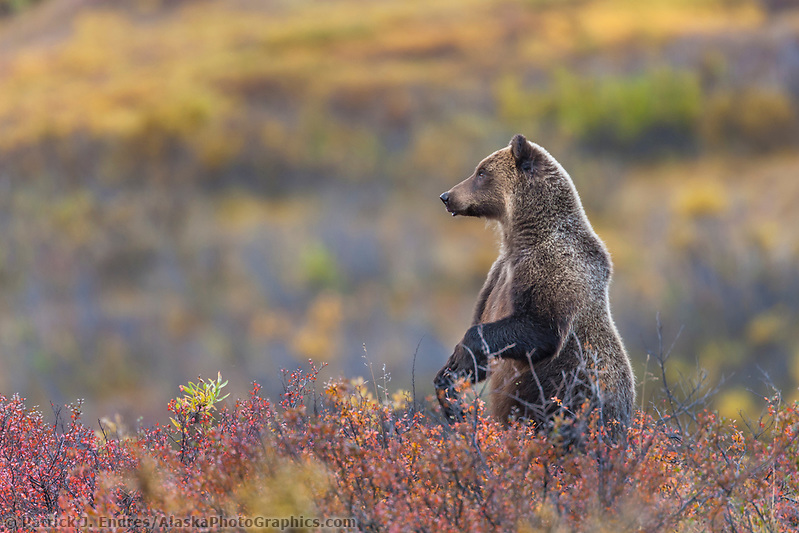
A grizzly bear stands on its hind legs on the autumn-colored tundra in Sable Pass in Denali National Park Ⓒ Patrick J. Endres / AlaskaPhotoGraphics.com.
Mating and offspring
Mating takes place from May through July, with the peak activity in early June. Brown bears generally do not have strong mating ties. Individual bears are rarely seen with a mate for more than a week. Males may mate with more than one female during the breeding season. The hairless young cubs, weighing less than a pound, are born the following January or February in a winter den. Offspring typically separate from their mothers as 2-year-olds in May or June. Following separation, the mother can breed again and produce a new litter of cubs the following year. In some parts of Alaska, research results reveal that offspring may not separate from their mothers until they are 3 to 5 years old. This appears to be most common in areas where food is scarce.
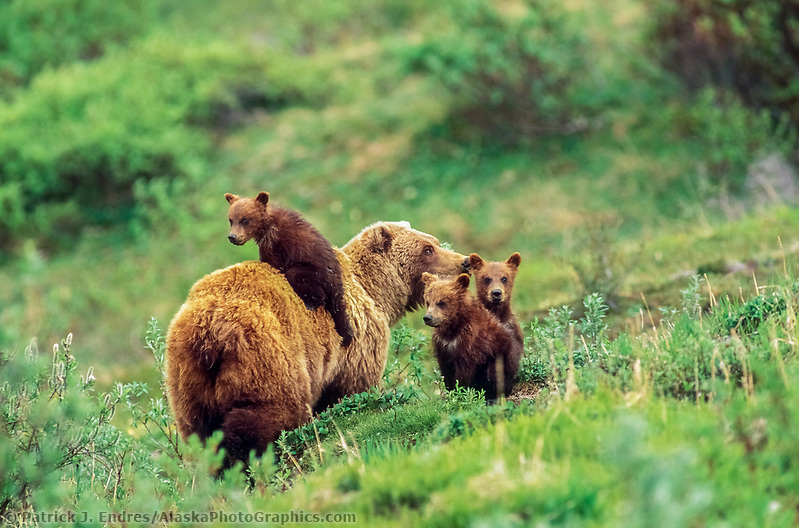
Sow grizzly bear and three (triplet) spring cubs; one jumped on her back on the green summer tundra in Denali National Park, Alaska. Ⓒ Patrick J. Endres / AlaskaPhotoGraphics.com
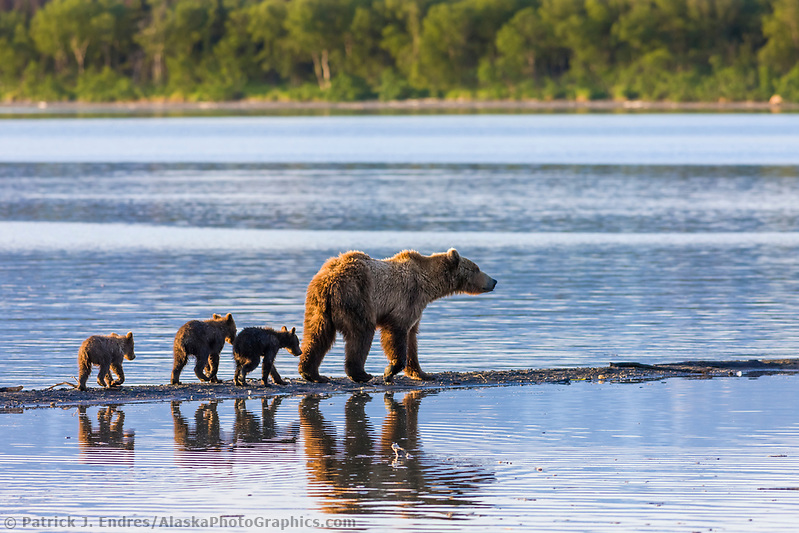
Brown bear sow and triplet cubs of the year, on the spit between Brooks river and Naknek Lake, Katmai National Park, southwest Alaska. Ⓒ Patrick J. Endres / AlaskaPhotoGraphics.com
Populations
Bear populations vary depending on the productivity of the environment. In areas of low productivity, such as on Alaska’s North Slope, studies have revealed bear densities as low as one bear per 300 square miles. In areas teeming with readily available food, such as Admiralty Island in Southeast Alaska, densities as high as one bear per square mile have been found. In central Alaska, north, and south of the Alaska Range, bear densities tend to be intermediate, about one bear per 15-23 square miles. These average figures should not be interpreted to mean that each bear has this much territory for its exclusive use. The area occupied by any individual bear may overlap with that many others use.
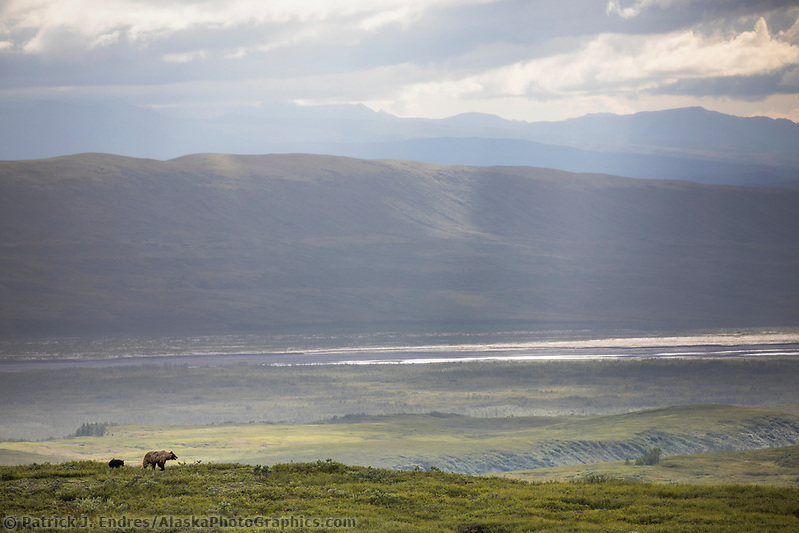
Sow grizzly walks across the green tundra overlooking the McKinley River bar in Denali National Park, Alaska (Patrick J Endres / AlaskaPhotoGraphics.com)
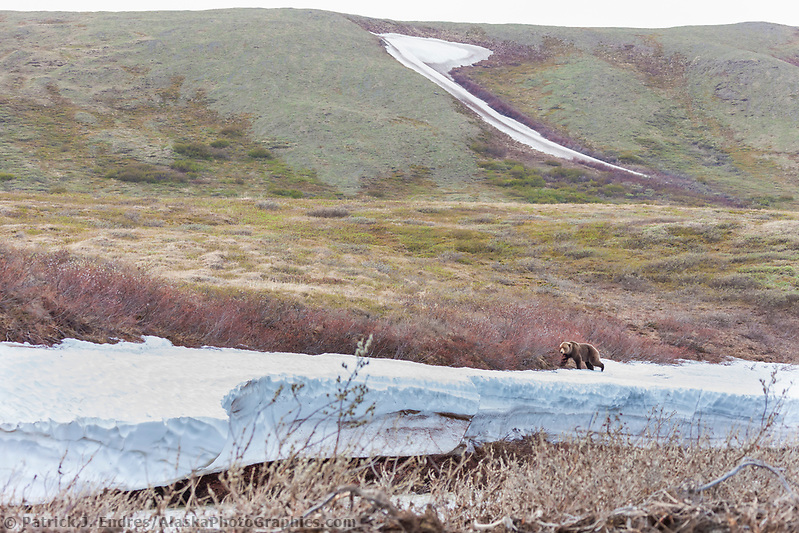
Grizzly bear along the Nigu river, National Petroleum Reserve, Alaska. Ⓒ Patrick J. Endres / AlaskaPhotoGraphics.com
Safety
All brown bears should be treated with respect and can be safely observed only from a distance of at least 100 yards. This is especially true for family groups of a female and her offspring, as mother bears are very protective towards their young. Bears protecting a food source, such as the buried carcass of a moose or caribou, should also be treated with particular caution. In bear country, campers can best avoid conflicts with bears if they minimize food odors, store their food out of a bear’s reach and away from their camp, and avoid camping on bear travel routes.
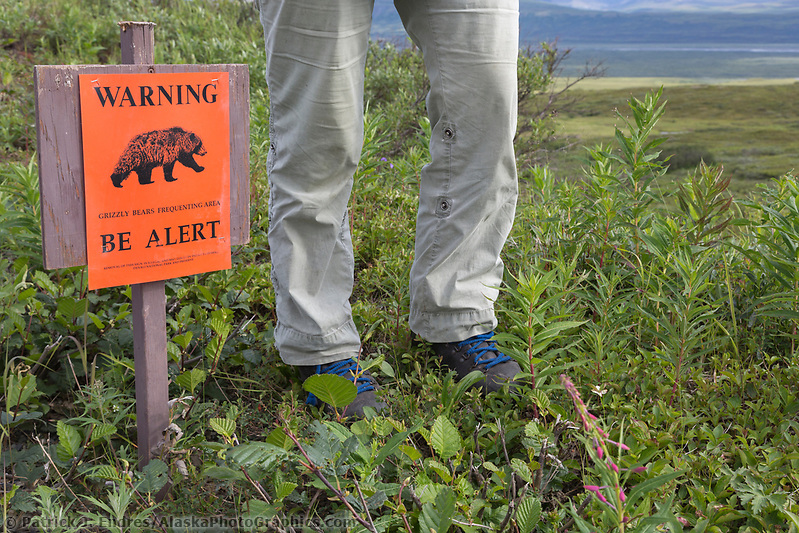
Denali National Park, Alaska (Patrick J Endres / AlaskaPhotoGraphics.com)
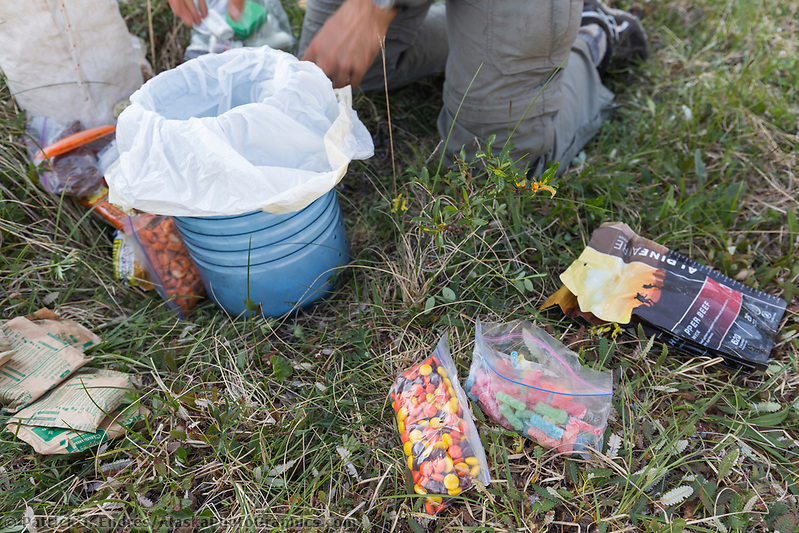
Storing food in a bear barrel is a safe way to keep bears from interacting with human food. Gates of the Arctic National Park, Alaska (Patrick J Endres / AlaskaPhotoGraphics.com)
Food habits
Like humans, brown bears consume a wide variety of foods. Common foods include berries, grasses, sedges, horsetails, cow parsnips, fish, ground squirrels, and roots of many kinds of plants. In some parts of Alaska, brown bears are capable predators of newborn moose and caribou. They can also kill and consume healthy adults of these species and domestic animals. Bears are fond of all types of carrion and garbage in human dumps. Except for females with offspring and breeding animals, bears are typically solitary creatures and avoid the company of other bears. Exceptions to this occur where food sources are concentrated, such as streams where bears can catch salmon swimming upstream to spawn. At McNeil River Falls, the largest concentration of brown bears occurs annually. Biologists have observed more than 60 bears at one time, attracted by spawning salmon.
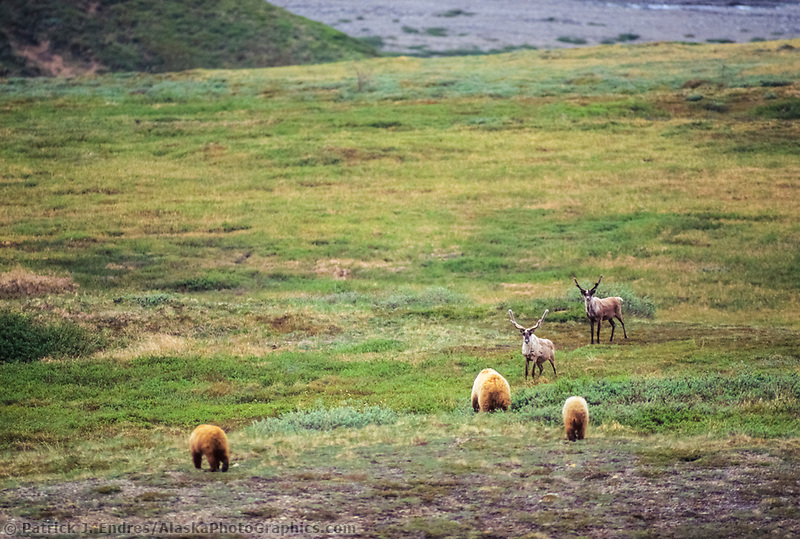
Grizzly bear sow and yearling cubs approach bull caribou, Denali National Park, Alaska Ⓒ Patrick J. Endres / AlaskaPhotoGraphics.com.
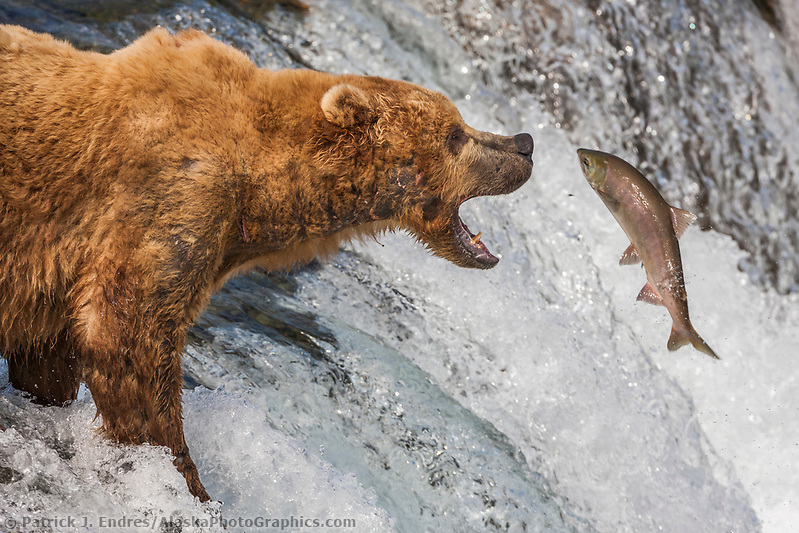
Brown bears fish for red salmon at the Brooks river falls, Katmai National Park, southwest Alaska. (Patrick J Endres / AlaskaPhotoGraphics.com)
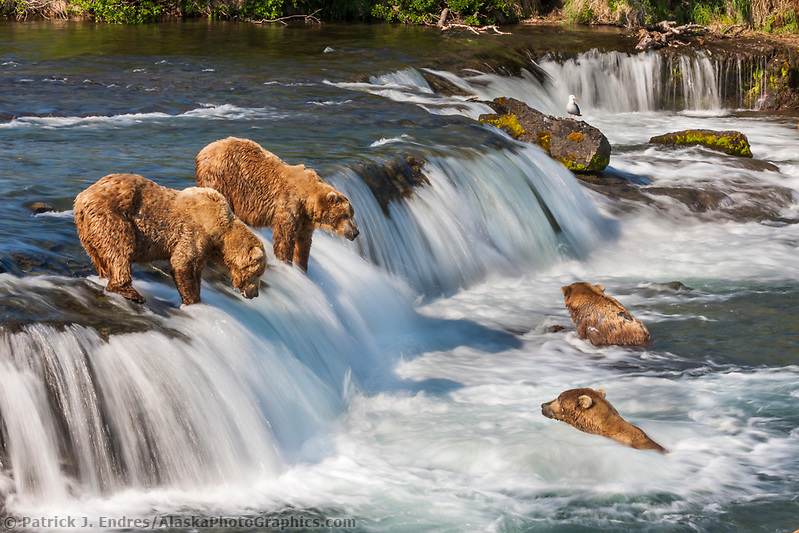
Brown bears fish for red salmon in the Brooks River, Katmai National Park, southwest Alaska. Ⓒ Patrick J. Endres / AlaskaPhotoGraphics.com
Winter
Most Alaska brown bears enter dens and hibernate through the winter when food is scarce. During hibernation, their body temperatures, heart rate, and other metabolic rates are reduced, and the need for food and water is eliminated. Bears may spend 5 to 7 ½ months in dens in northern areas with long brutal winters. A few bears may stay active all winter in areas with relatively warmer winters, such as Kodiak Island. Pregnant females are usually the first to enter dens in the fall and the last to exit with their newborn cubs in the spring. Adult males, on the other hand, appear to enter dens later and emerge earlier than most other bears.
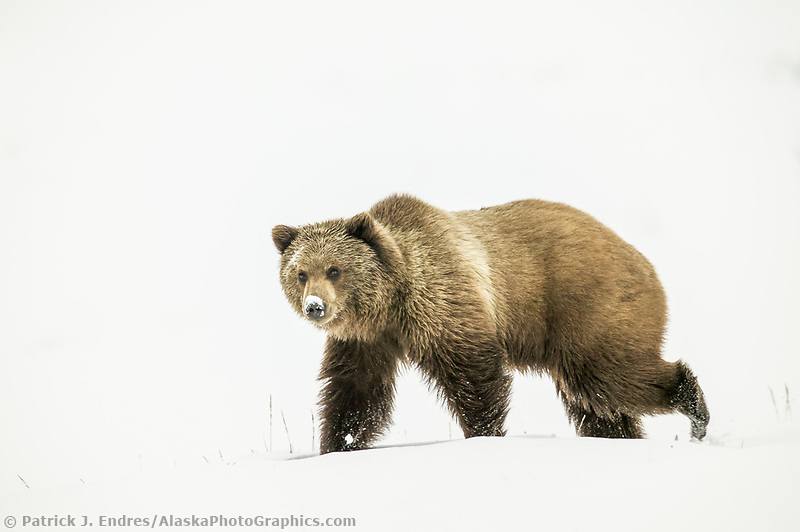
Grizzly bear in the fresh winter snow in Atigun canyon, Brooks Range, Alaska (Patrick J Endres / AlaskaPhotoGraphics.com)
Research and conservation
Alaska contains most of the United States brown bears, and The Alaska Department of Fish and Game is responsible for managing the population based on scientific studies of the biology of bear populations. Essential components include preserving bear habitat, overharvesting prevention, and conducting the studies necessary to understand population requirements. As Alaska continues to develop, it is increasingly essential for the public to recognize that maintaining sufficient amounts of habitat for brown bears to continue to thrive in Alaska will mean forgoing opportunities for some kinds of economic development in some places.
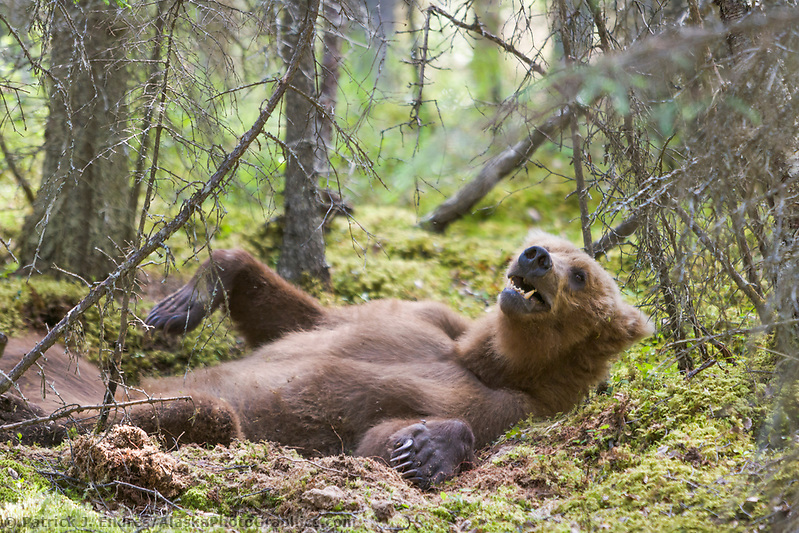
Brown bear lies in the forest floor’s moss along a trail in Katmai National Park, Alaska Ⓒ Patrick J. Endres / AlaskaPhotoGraphics.com.
Information referenced from the Alaska Department of Fish and Game Wildlife Notebook Series
